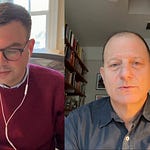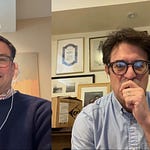Glenn Kessler, the fact-checking columnist who recently concluded a 28-year career at the Washington Post and recently launched the BY GLENN KESSLER Substack, joined me yesterday to talk about some of the issues raised in his article “Why I left the Washington Post.”
I asked him about the erosion of popular trust in fact-checking by elite institutions. One topic that came up along the way was whether fact-checkers prematurely declared false the “lab leak” theory of the Covid-19 virus’s origins.
Kessler was admirably forthright in acknowledging that he’d gotten wrong a Washington Post headline on that topic.
“I screwed up…I was completely wrong,” he told me, speaking of what he called his “infinite regret” at a headline casting doubt on the lab-leak theory.
“Everyone makes mistakes. No one is perfect. And when you’ve got a title like ‘the fact checker,’ when you make a mistake, people notice. So, you know, you’ve got to own it,” he said.
Yet he said reporters and publications should be judged by the entire body of their work, not by a few high-profile errors. “I wrote or edited 3,000 fact-checks. Yes, there might be a dozen bad apples there.”
“It’s easy and kind of facile to pick at a particular piece and say that defines a person,” he said. “Every reporter writes lots of stories, and sometimes they get things wrong. The important thing is to be open and transparent and say, okay, I messed up, which is what I try to do.”
Kessler also spoke about what he described as the “fracturing of the information environment,” a change from the days when a few voices like Walter Cronkite on the CBS evening news were commonly watched. “My message has always been, diversify your feed. I personally learn more from people I disagree with than people I agree with,” Kessler said.
The full video is above along with a very, very rough machine-generated transcript. We also discussed whether the left-leaning readership of the Washington Post affects the news content, and why so many news organizations no longer employ ombudsmen or public editors to investigate and explain to the public about the workings of news organizations. I enjoyed the conversation and I appreciate that Kessler was willing to do it. Thanks to all the readers who tuned in via the Substack app to watch it live.
Thank you! This is a reader-supported publication. If you are learning things here that you are not getting elsewhere, please consider becoming a paid subscriber. Paid subscribers have full access to all the content and are helping to sustain our growth and editorial independence. Thanks to those who have already pitched in, at a price of as little as $1.54 a week. If you have trouble making it work on a phone, try a desktop, or if you have trouble on a desktop, try a phone. Or ask some youngster to give you a hand.








